Features of growing lithops from seeds at home
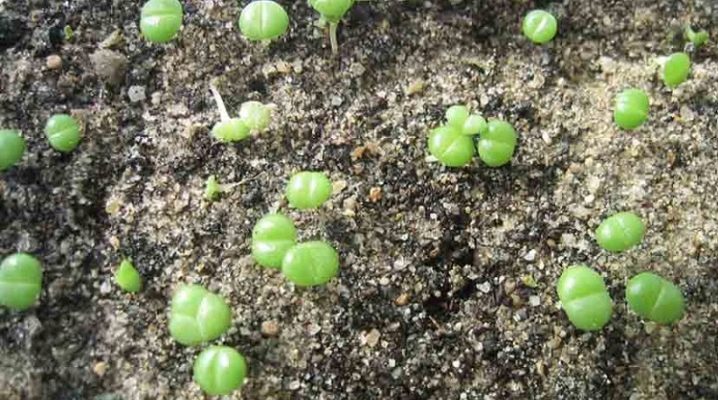
Indoor flowers are found in almost every home, but flowers such as lithops are rare. Having seen such flowers once, it is impossible to forget them. Therefore, it is worth considering in detail the cultivation of lithops from seeds at home in order to settle these amazing plants in your home.

Description
Lithops are indoor potted plants related to succulents. However, given the right environmental conditions, these "living stones" can also be grown outdoors. These plants are native to the desert. It is because of the harsh environmental conditions that the appearance of these plants is unique - they do not have a stem, classic leaves are practically absent, they almost do not grow tall.
The height of the lithops does not exceed 3 cm, and in appearance they very much resemble two small pebbles connected to each other at the bottom. A distinctive feature of these indoor plants is the minimum consumption of not only moisture, but also various nutrients from the substrate. However, despite this, they are quite demanding on the conditions of their cultivation.

Seed material
It is on its quality that the success of growing lithops at home depends. It is best to use fresh seeds from two mature flowering plants. The seeds will be inside a small box that will appear in place of the flower. But if it is impossible to use the material collected with your own hands, then you can turn your gaze to retail chains.
Although Lithops seeds retain good germination for 10 years after ripening, should choose as fresh material as possible. It is recommended to give preference to products from well-known manufacturers that have long been known on the market. Better yet, choose the seeds of those firms that specialize in precisely on the sale of material and related products for indoor plants.
Important! If the seeds come out of the box on their own, then you just need to substitute it under a stream of water, and they themselves will fall out of it.
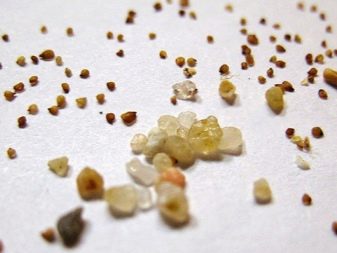
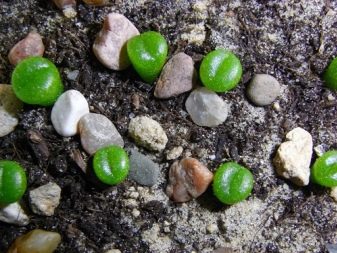
How to grow it yourself?
There are no particular difficulties here, but it is very important to follow both the sequence of actions and all the recommendations. Otherwise, it may not be possible to grow lithops from seeds on your own. The best time to plant is during winter and spring. At the same time, it is better for beginners to choose a time closer to summer. It is worth remembering here that seed material is very picky about attention, especially in the initial stages.
Therefore, the planting time should be chosen so that it is possible to regularly monitor the seedlings and development of the lithops themselves.
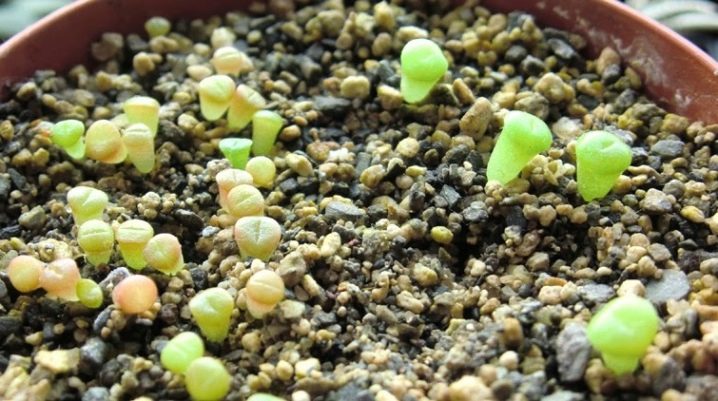
Important nuances of landing
Before you start growing lithops at home on your own, you should pay attention to the following points:
- if sowing is carried out in winter, then it is necessary to take care of an additional source of artificial lighting in advance;
- it is best to abandon planting seeds in the summer - it will not be possible to provide the sharp temperature drops necessary for the normal growth of the plant;
- if necessary, you can propagate lithops and vegetatively - it is worth knowing that the dormant period for a flower lasts from June to August, and the best planting time in this case will be January or February, after it ends with flowering.
Important! When purchasing seeds from the manufacturer, before purchasing, you should carefully check the integrity of the packaging, since it is it that ensures the safety of the high germination rates of the material.
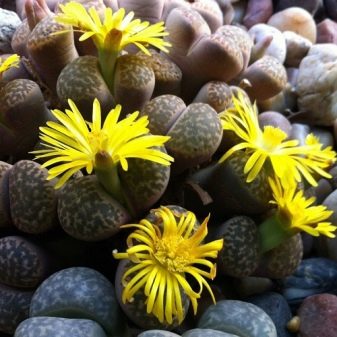
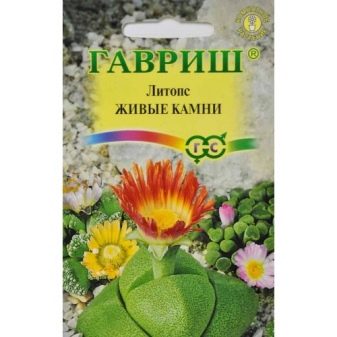
Capacity and substrate
Do not think that since lithops practically do not absorb water and nutrients, then you should not worry about choosing the right container and substrate. For successful germination of seeds and their normal growth and development, it is necessary to take care of the availability quality soil... Necessarily needed and drainage, ordinary fine gravel is also great. Its volume should be about a third of the total volume of the substrate required for planting lithops.
Soil for sowing seed and further cultivation of lithops should be prepared independently. Experienced growers recommend the following mixtures to choose from:
- perlite and coke oven in proportions 1: 1;
- earth, sand, pumice and perlite - 1: 2: 2: 2;
- forest soil or pumice and river sand - 3: 1;
- finely crushed brick, sod land, river sand, clay and peat –1: 2: 2: 1: 1.
The selected mixture must be calcined in the oven at a temperature of +120 degrees for 1 hour before use, and then cool completely.
Some growers advise adding a little furnace ash to the substrate mixture - about 100 g per 1 kg of soil.

How to plant?
Selected seeds must first be placed in a warm solution of ordinary potassium permanganate for 6 hours. If it is not there, you can use ordinary warm water, adding 1 tsp to it. baking soda per 1 liter of water. At this time, the container is first filled with drainage by 1/3 of its volume, and the rest of the space is filled with prepared soil. Wherein there should be a distance of no more than 1 cm from the top edge of the pot to the substrate.
Further, the seeds are spread evenly over the entire surface of the soil - do not sprinkle them with a substrate on top... They should be planted at a distance of about 3-4 cm from each other. The container is covered on top with thin cling film or glass and placed in a well-lit place, but not in direct sunlight.

How to care for seedlings?
The first few days, or even weeks, of planting, you need to pay close attention. It is necessary to control not only the intensity of seedlings, but also the humidity of the air, the ambient temperature and the state of the young plants themselves.
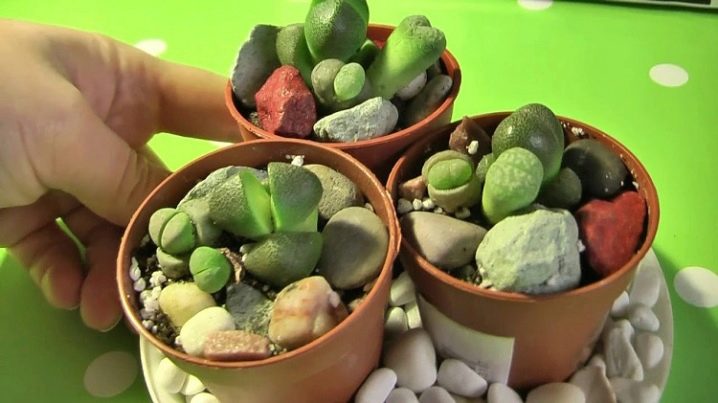
Temperature and light intensity
Covering material in the summer season is left for 4-7 weeks, while a month later, its volume is increased. In winter, the shelter is left for a period of 1.5–2 times longer, while its volume is increased. Lithops must be well lit at all times, otherwise the leaves will begin to change their color and stretch out strongly. The optimal temperature for them is considered at night from +15 to +18 degrees, and in the daytime from +28 to +30 degrees. It is very important to ventilate the room daily by lifting the protective film on the container.
Lithops react extremely negatively to stagnant indoor air.
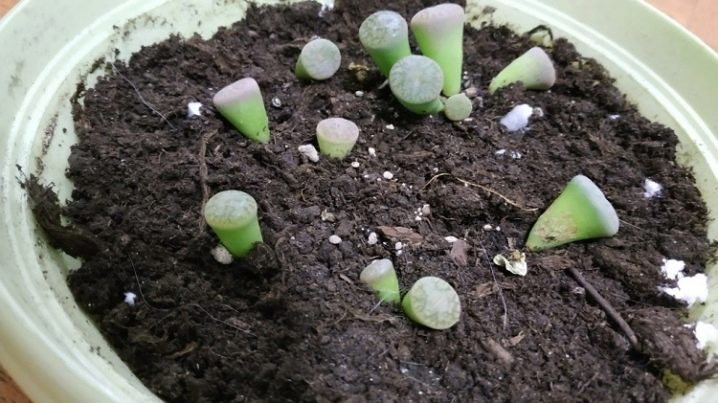
Moisture and plant nutrition
These are two more important factors that have a direct impact on the growth, development, health and intensity of flowering of lithops. It is necessary to irrigate only seedlings daily, without affecting the soil itself with warm water. After the emergence of mass shoots the room is ventilated 4 times a day for 20 minutes at regular intervals. If the seedlings of lithops did not appear 10 days after sowing, then the seed material was of poor quality and it is not possible to grow "living stones" from it at home.
Watering is extremely rare. For this, a small amount of it is poured with a tablespoon directly under the root of the flower. Particular attention should be paid to ensure that moisture does not fall between the leaves in the place where the flower itself appears - otherwise the lithopsis will begin to rot. In autumn and winter, this type of succulent is not watered at all, but only irrigated 1-2 times a week. Lithops do not need special feeding,but if desired, they can be fertilized with a small amount of any mineral fertilizer once a yearotherwise, the plant must be transplanted into a larger container.
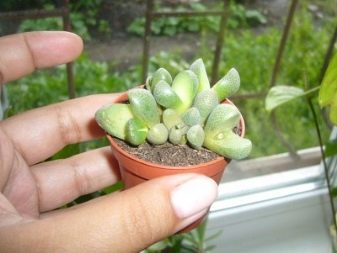
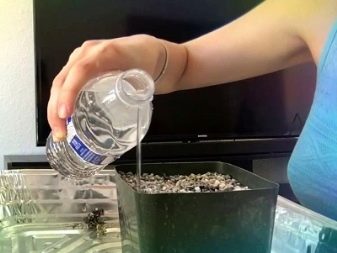
Transfer
These plants are planted only in groups of at least 3. Lithops are picked during the active period of their flowering. The soil is prepared in the same way as for sowing seeds. The first transplant is allowed only after these succulents have survived at least one winter. After the procedure the surface of the substrate is mulched - so the flowers will receive additional support.
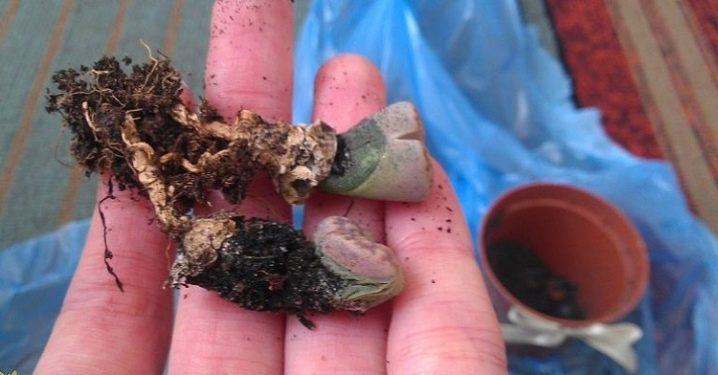
How to grow outdoors?
In the hot season, from about the end of May until the first days of September, these succulents can be grown outdoors. To do this, they are simply taken out in pots and installed outside in such a way that moisture does not fall on them, as well as direct sunlight. The care of the plant is the same as in the case of growing them in the room. The difference is that irrigate the soil regularly when the temperature rises above +33 degrees. If the nights have become too cold, then it is necessary to return the lithops to the room.
These plants look amazing and unusual. From the first minutes they attract all the attention to themselves. Observing all the above simple recommendations, everyone can become the owner of such a beautiful and truly unique succulent in their home, like lithops.
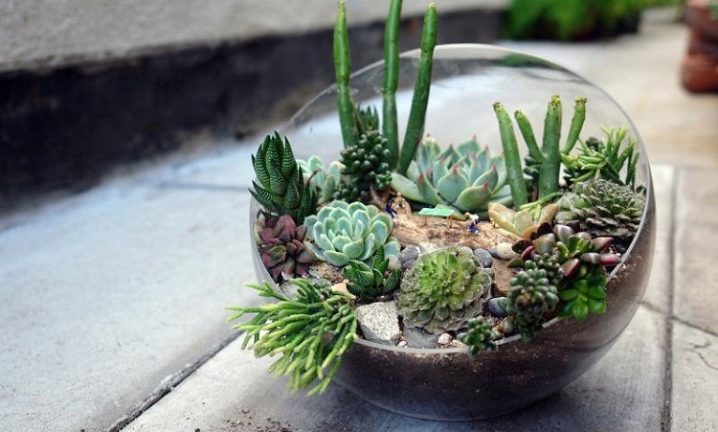
You can learn how to plant lithops from the following video.
















































The comment was sent successfully.